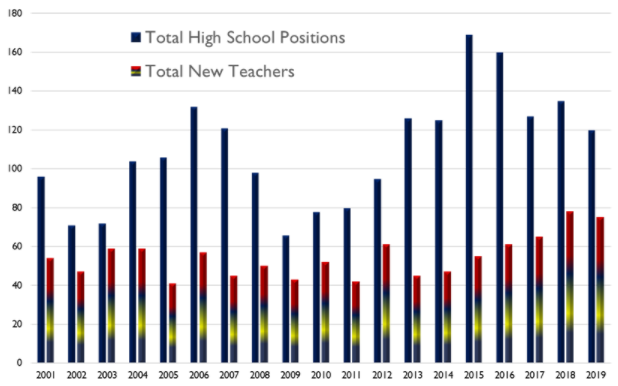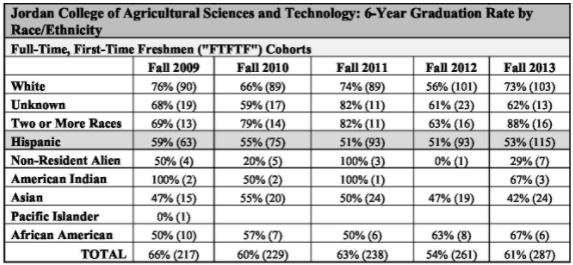AAQEP Accreditation
Standard 4 Aspect A
The program is committed to and invests in strengthening and improving the education profession and the P-20 education system. Each program’s context (or multiple contexts) provides particular opportunities to engage the field’s shared challenges and to foster and support innovation. Engagement with critical issues is essential and must be contextualized. Sharing results of contextualized engagement and innovation supports the field’s collective effort to address education’s most pressing challenges through improvement and innovation.
Overview of Involvement with Partners and Stakeholders
The Ag Specialist program is deeply embedded in the Central Valley community. For
example, the coordinator meets with the Agricultural Education Advisory Committee
on matters related to the credential program. This committee establishes the vision
for the program and provides an assessment function. The advisory committee consists
of high school and community college teachers of agriculture and representatives from
agribusiness and farming. The committee provides one of many kinds of contacts between
the program and the community served by the program.
The program coordinator also meets regularly with other universities offering Single Subject – Agriculture Specialist Credentials. Representatives of these universities and the California Agricultural Education State Staff meet about four times each year to discuss and coordinate statewide issues and activities. The program coordinator attends these meetings. Other Agricultural Education faculty members have committee responsibilities and attend all or part of these meetings. This collaboration results in coordinated statewide programs for agriculture student teachers, cooperating teachers, and new professionals.
Overall, the Ag Specialist program supports local district partners and county stakeholders through credentialing teachers and specialists in agricultural education.
Documenting Existing Work:
Partnership/Advisory Board 1: California Future Farmers of American (FFA) Board of
Directors
Dr. Steven Rocca, Teacher Educator Representative
How often meet: Twice annually and additional meetings as needed.
Description of group’s purpose/function: Oversee the business operation, personnel and budget of the California Future Farmers of American (FFA) Association, which consists of over 90,000 middle and high school agriculture students at over 320 schools throughout California.
Examples of specific challenge/identified need: Reducing the cost of registration fees for all students to ensure that those individuals and FFA chapters with limited financial resources can participate in statewide FFA leadership development events.
Discussion of steps taken to address challenge/identified need: In collaboration with the state’s FFA Foundation, the FFA Board of Directors hired a development staff member to develop partnerships and solicit sponsors for our annual leadership development conferences. These sponsorship opportunities have resulted in substantial donations which have greatly reduced the registration fees charged to students and their chapters to participate in FFA events. The reduced fees have meant that schools have been able to have additional students participate in these conferences, which may not have been possible without the fee reduction.
Partnership/Advisory Board 2: California Department of Education Agricultural Education State Staff / Teacher Educators’ team meetings
Dr. Rosco Vaughn, Dr. Sherri Freeman, Dr. Steven Rocca, team members representing Fresno State.
How often meet: Twice annually
Description of group’s purpose/function: California Dept. of Education staff (6 regional consultants, the state assistant FFA advisor and the state director) and representatives from the 5 Ag teacher preparation programs meet as a group to address statewide issues, such as teacher supply and demand, and evaluate and plan professional development programs.
Examples of specific challenge/identified need:
Agricultural Education faces an ongoing shortage of qualified secondary agricultural
educators across the state and the nation. The California Department of Education
(CDE) Ag Education staff, along with the teacher education representatives, review
the state’s agriculture teachers supply and demand data annually. The group has identified
the need for additional recruiting efforts and projects to increase the number of
teacher candidates statewide. The following chart illustrates the state’s agriculture
teacher shortage from 2001-2019 with teaching positions in blue and the multiple color
bar representing the new candidates from the five teacher preparation programs. 
This statewide collaboration has led to a Teach Ag campaign which includes their website. This project is supported by the California Dept. of Education Ag Education Division. The Ag Education program at Fresno State has also collaborated with local community colleges on two different agriculture teacher pipeline grants. These grants were funded through the United State Department of Agriculture Hispanic Serving Institution’s (USDA HSI) Educational Grant program to increase the number of underrepresented students pursuing and completing the Agricultural Education Teacher Preparation program at Fresno State. Both projects sought to strengthen the academic programs at Fresno State and at the community college by filling a void in the academic programs at these institutions by providing students with information, field experience, training, and career awareness related to agricultural education. Additionally, without these projects, an early field experience course would not be available to students at each community college due to problems acquiring adequate enrollment numbers in the course when offered independently. These projects have created a pathway for students to make a smooth transition into the university’s program. With a clear pathway in place, greater attention can be placed on attracting students toward a career in agricultural education. Additionally, an increased number of Hispanic teachers would provide the profession with much needed role models to help inspire the thousands of Hispanic students in our state who might otherwise view higher education and a career in agriculture as an unlikely option.
Agricultural Education Teacher Pipeline Recruitment Projects:
Rocca, S. J. (2013-2016). Project Director. Pathway to Agricultural Education: Recruitment, Preparation, and Careers. United States Department of Agriculture, Hispanic Serving Institutions Education Grant. $240,000.
Rocca, S. J. (2010-2013). Project Director. Opening Doors in Agricultural Education: Recruitment, Preparation, and Careers. United States Department of Agriculture, Hispanic Serving Institutions Education Grant. $290,000.
Partnership/Advisory Board 4: United States Department of Education STEAM: Enriched Pathways Grant
Dr. Steven Rocca, Jordan College of Ag. Sciences and Technology Coordinator
How often meet: Twice monthly
Description of group’s purpose/function: Dr. Rocca serves as the Jordan College’s coordinator for a 5 year $3 million project funded by a U.S. Department of Education Hispanic Serving Institutions grant. The purpose of the project is to increase the number of Hispanic students entering and completing college degree programs in science, technology, engineering, agriculture and mathematics. Dr. Rocca serves along with the Deans and coordinators from the College of Science and Mathematics and the Lyles College of Engineering on the grant team.
STEAM: Enriched Pathways inspires Hispanic students to achieve their dreams of becoming scientists and engineers. The goal of the proposed project is to democratize access to academic success. This goal is achieved through efficient “guided pathways-plus” to earn a Bachelor’s in high demand STEAM fields. “STEAM” denotes all the STEM majors at California State University, Fresno, plus Agricultural Sciences and Technology (hence, “STEAM”). Including Agricultural Sciences and Technology (i) is responsive to a major economic engine in the region; (ii) offers a transformative pathway to leadership for the Hispanic workforce historically exploited by that engine; and (iii) includes all STEAM disciplines that significantly overlap in the Central Valley’s “food – water – energy” nexus.
Examples of specific challenge/identified need:
Activity Objective 1. To increase overall persistence from one year to the next in
Bachelor’s degree programs in STEAM disciplines by 25% during the five-year grant
period (average 5% increase each year over 2019-2020 baseline) and to sustain improved
persistence rate after the grant period with no additional federal cost.
Activity Objective 2. To increase persistence from one year to the next of Hispanic students in Bachelor’s degree programs in STEAM disciplines by 40% during the five-year grant period (average 8% increase each year over 2019-2020 baseline) and to sustain improved persistence rate after the grant period with no additional federal cost.
Activity Objective 3. To increase 25%, over the five-year grant period, the overall number of Bachelor’s degrees awarded in STEAM disciplines (5% increase each year over 2019- 2020 baseline) and to sustain improved attainment rate after the grant period with no additional federal cost.
Activity Objective 4. To increase 40%, over the five-year grant period, the number of Bachelor’s degrees awarded to Hispanic students in STEAM disciplines (average 8% increase each year over 2019-2020 baseline) and to sustain improved attainment rate after the grant period with no additional federal cost.
Table 1: 6 year Graduation Rate, Jordan College of Agricultural Sciences and Technology
Discussion of steps taken to address challenge / identified need:
The STEAM grant team has identified six focus areas to be addressed to achieve the objectives of this project:
1. CURES (Course-based Undergraduate Research Experiences)
Goal: To develop high quality Affinity Research Groups (ARGs) structured as “Research,
Design, and Innovation” experiences linked to the regional economy.
Action plan: Provide training for faculty to integrate quality ARGs into courses. Conduct Summer Institutes (workshops) to annually train 40 faculty. Every student has the opportunity for at least one research experience during lower division years, where attrition is the greatest challenge.
2. WBLO (Work-Based Learning Opportunities)
Goal: Increase WBLOs by 50%, including but limited to, internships, student research
projects, farm/enterprise projects, and micro/course based internships. The goal is
for each student to have two WBLO experiences during their degree program.
3. Employer/Industry Partnerships
Goal: Develop 10 new collaborations annually (50 total for JCAST), enabling more research
experiences based on regional economy needs and increase the number of WBLOs.
4. Financial Literacy and Financial/Career Planning
Goal: Incorporate career and financial planning modules/instruction into first year
course curriculum.
5. Endowment
Goal: Identify sources and pursue funds to match $120,000 per year to establish endowment.
Plans for Future Stakeholder Involvement:
Engage the Agricultural Education Program Advisory Board and other stakeholders in
the analysis of program data and the action planning process. This effort will be
an ongoing agenda topic for our advising board with a specific focus on revising the
program--with the goal of having revisions completed for the fall 2024 semester.
Who will you involve? Why?
Local secondary agricultural programs and stakeholders who will analyze data and assist
in the planning and implementations of program improvement initiatives.
How often will you meet?
Meetings would be held as needed.
How will you ensure all individuals have a voice?
By facilitating an open conversation about the program's needs and seeking feedback
from various stakeholders.
What data might you together examine to inform your work?
Local workforce data would be useful to determine if the agricultural program curriculum
reflects the actual workforce needs in that community.